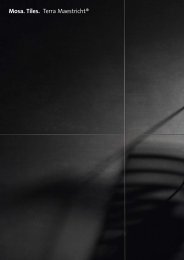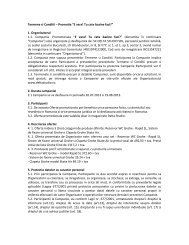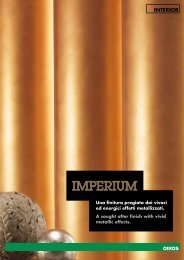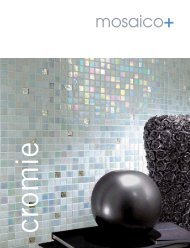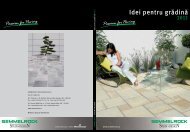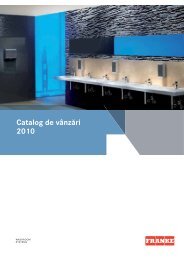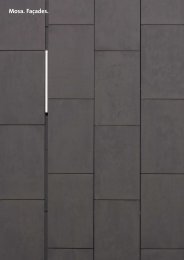series urbatek - Delta Studio
series urbatek - Delta Studio
series urbatek - Delta Studio
You also want an ePaper? Increase the reach of your titles
YUMPU automatically turns print PDFs into web optimized ePapers that Google loves.
242<br />
INSTRUCCIONES DE COLOCACIÓN / TYLE-LAYING INSTRUCTIONS<br />
Resulta de gran importancia, en la colocación, la elección de las herramientas y útiles adecuados (tanto la llana dentada,<br />
como la maza de goma, siempre de goma blanca, ventosas y crucetas para la colocación y la llanta de goma para el rejuntado<br />
It is essential to choose the right tools and utensils to lay the tiles (a notched trowel, rubber mallet, always white rubber, suction<br />
pads, and spacers for laying the tiles and a rubber trowel to grout them).<br />
Hay que considerar en cualquier caso la presencia de juntas perimetrales que ayudarán a absorver cualquier movimiento<br />
post-obra. Estas juntas han de permanecer vacías o rellernas de cualquier material comprensible y deben tener una anchura<br />
mínima de 8mm.<br />
Esta junta se disimula con el zócalo o con el propio azulejo.<br />
In all cases, perimeter joints must be incorporated, since they will help to absorb any movements after the tiles have been laid.<br />
<br />
joints can be concealed by skirtings or by the tiles themselves.<br />
INFORMACIÓN TÉCNICA<br />
El soporte (pared o suelo) que se va a revestir debe estar perfectamente nivelado, no presentando defectos de plenitud.<br />
Recomendamos la impermeabilización previa de los ambientes húmedos. Una diferencia en el grosor de la capa de adhesivo<br />
<br />
<br />
<br />
tiled surface, leading to uneven ridges.<br />
<br />
las baldosas. Así se facilita una mejor adherencia del material de agarre sobre el soporte utilizado.<br />
<br />
<br />
Si el soporte lleva ya sus propias juntas estructurales o de partición, éstas deben respetarse cuando se proceda a la colocación<br />
<br />
de 50m2 a 70m2 si se trata de un interior,y de la mitad si se trata de un ambiente exterior. Durante la fase de colocación, cuando<br />
<br />
ya colocado, ya que todavía estamos a tiempo de corregir cualquier defecto de colocación, utilizando para ello el mazo de goma<br />
(siempre blanco) y las ventosas.<br />
If the substrate already contains structural or intermediate movement joints, they must be maintained when the tiles are laid.<br />
<br />
that amount in outdoor ones. During the tile-laying process, when the adhesive has still not fully set (particularly at the end of<br />
the day or beginning of the next day), any tiles that have already been laid must be checked, since there is still time to correct any<br />
tile-laying defects, using a rubber mallet (always use a white one) and suction pads.<br />
Antes del rejuntado comprobaremos que las juntas de colocación (entre baldosa y baldosa) están vacías y limpias del material<br />
<br />
además la adherencia del material de juntas.<br />
<br />
can detract from the end result of the tile joints and also reduce the bonding strength of the grout.<br />
Durante la colocación, la intensidad de luz debe ser tal que nos permita distinguir con facilidad la presencia de cualquier<br />
defecto, en especial la aparición de “cejas”. Durante esta fase, se debe trabajar con una intensidad de luz superior a la que<br />
<br />
During the tile-laying process, the light should be good enough to make it easy to see any defects, particularly uneven ridges.<br />
<br />
Using spotlights will help overcome this problem.<br />
El relleno de juntas se realiza cuando las baldosas se encuentren perfectamente adheridas al soporte. En el caso especial<br />
<br />
<br />
<br />
<br />
any kind of load.<br />
La elección del tipo adhesivo a emplear resulta fundamental. Se debe tener en cuenta las propiedades del soporte que vamos<br />
<br />
<br />
<br />
de colocación como sobre el dorso de la baldosa cerámica.<br />
<br />
<br />
<br />
<br />
back of the tiles.<br />
El material rejuntado se aplicará con llana de goma, evitando en todo momento la utilización de llanas metálicas, que puedan<br />
<br />
la uniformidad de tono de cualquier ambiente. No se debe utilizar nunca junta de color negro, que contenga negro de humo<br />
<br />
<br />
<br />
recommend Butech adhesives and grouts for all our tiles. Grouts are available in a wide range of colours to match or contrast<br />
with the colour of the tiled surface. Do not use grouts that contain micronized coal. as they may mark the tiles surface and cause<br />
damage.<br />
Todas las baldosas de porcelánico técnico requieren una manipulación cuidadosa para evitar despuntados, desconchados o<br />
<br />
inferior a 1,5mm entre pieza y pieza. En la colocación de los formatos URBATEK se recomienda utilizar crucetas de 2mm. Para<br />
formatos rectangulares, cuando se colocan a junta trabada, se aconseja igualmente colocar 3/4 de pieza. En los paros de<br />
colocación, se debe tener en cuenta que el material ya colocado ha retraído y que el que vamos a colocar va a sufrir el mismo<br />
movimiento. Se debe predecir, por lo tanto, el posible movimiento o retracción, ya que si seguimos colocando al mismo nivel,<br />
la posterior retracción puede originar un pequeño desnivel.<br />
<br />
<br />
<br />
<br />
been laid will have undergone some shrinkage and that the same will happen to the new material. You must therefore calcula-te<br />
how much the material will move or shrink, because if you continue to lay the tiles at the same level, you might end up with an<br />
uneven ridge.<br />
La retirada de los restos de material de rejuntado se debe realizar utilizando una esponja humedecida en agua limpia. Esta<br />
<br />
<br />
la instalación del pavimento es imprescindible la protección del material ya colocado con sistemas adecuados para impedir<br />
<br />
De esta forma, además de la protección delmaterial, se facilitan así las posteriores tareas de limpieza. Se deben evitar agentes<br />
<br />
<br />
<br />
performed relatively swiftly, because if the grouting material is in contact with the glazed surface for too long, it will be hard to<br />
<br />
<br />
moved back and forth etc. In this way, not only will the material be protected, but it will facilitate any subsequent cleaning. Cleaning<br />
<br />
acid will remove the glazed surface of the tiles, causing irreparable damage.



